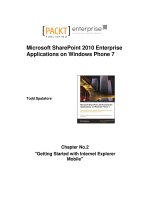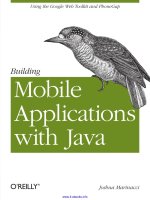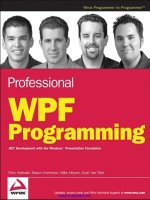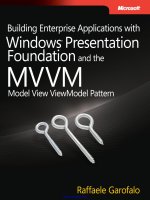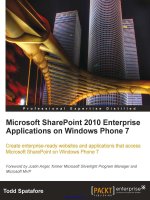Building Enterprise Applications with Windows Presentation Foundation and the Model View ViewModel Pattern doc
Bạn đang xem bản rút gọn của tài liệu. Xem và tải ngay bản đầy đủ của tài liệu tại đây (7.25 MB, 225 trang )
www.it-ebooks.info
Building Enterprise
Applications with Windows
®
Presentation Foundation and
the Model View ViewModel
Pattern
Raffaele Garofalo
www.it-ebooks.info
Published with the authorization of Microsoft Corporation by:
O’Reilly Media, Inc.
1005 Gravenstein Highway North
Sebastopol, California 95472
Copyright © 2011 Raffaele Garofalo.
Complying with all applicable copyright laws is the responsibility of the user. All rights reserved. Without limiting the
rights under copyright, no part of this document may be reproduced, stored in or introduced into a retrieval system, or
transmitted in any form or by any means (electronic, mechanical, photocopying, recording, or otherwise), or for any
purpose, without express written permission of O’Reilly Media, Inc.
Printed and bound in the United States of America.
1 2 3 4 5 6 7 8 9 LSI 6 5 4 3 2 1
Microsoft Press titles may be purchased for educational, business or sales promotional use. Online editions are also
available for most titles (). For more information, contact our corporate/institutional
sales department: (800) 998-9938 or Visit our website at microsoftpress.oreilly.com. Send
comments to
Microsoft, Microsoft Press, ActiveX, Excel, FrontPage, Internet Explorer, PowerPoint, SharePoint, Webdings, Windows,
and Windows 7 are either registered trademarks or trademarks of Microsoft Corporation in the United States and/or
other countries. Other product and company names mentioned herein may be the trademarks of their respective owners.
Unless otherwise noted, the example companies, organizations, products, domain names, e-mail addresses, logos,
people, places, and events depicted herein are ctitious, and no association with any real company, organization, prod-
uct, domain name, e-mail address, logo, person, place, or event is intended or should be inferred.
This book expresses the author’s views and opinions. The information contained in this book is provided without any
express, statutory, or implied warranties. Neither the author, O’Reilly Media, Inc., Microsoft Corporation, nor their
respective resellers or distributors, will be held liable for any damages caused or alleged to be caused either directly
or indirectly by such information.
Acquisitions and Development Editor: Russell Jones
Production Editor: Kristen Borg
Production Services: Octal Publishing, Inc.
Technical Reviewer: David Hill
Indexing: Fred Brown
Cover: Karen Montgomery
Illustrator: Robert Romano
978-0-735-65092-3
www.it-ebooks.info
To my wife Deborah. Thank you for everything!
www.it-ebooks.info
www.it-ebooks.info
Contents at a Glance
www.it-ebooks.info
www.it-ebooks.info
Table of Contents
Introduction xi
Conventions and Features in This Book xv
Acknowledgments xviii
Errata and Book Support xix
Introduction to Model View ViewModel and Line of Business
Applications 1
The Model View ViewModel Pattern 1
Line of Business Applications 2
Choosing the Right Technology 3
Silverlight or WPF? 4
Microsoft’s UI-Building Tools 5
Composition of a LOB User Interface 9
The Menubar 11
The Toolbar 12
The Tooltip (and Its Abuse) 12
Notications and Alerts 13
The Ribbon Bar 15
General Style and Control Considerations 16
Separation of Concerns 17
Layers, Tiers, and Services 19
Summary 23
Design Patterns 25
An Overview of Design Patterns 25
Classifying Design Patterns 26
UI Design Patterns 29
The MVC Pattern 30
The MVP Pattern 34
The PM Pattern and MVVM 39
Advanced Design Patterns and Techniques 43
The Inversion of Control Pattern 44
DSLs: Writing Fluent Code 53
Introduction to TDD 57
Summary 60
www.it-ebooks.info
Table of Contents
The Domain Model 61
Introduction to Domain-Driven Design 61
DDD Terminology 62
Analyzing the CRM Domain 63
Domain Entity and Data Transfer Object 64
The POCO Object and the O/RM 66
Development Approaches of a Domain 67
Transaction Script 68
Database-Driven Approach 69
Domain-Driven Approach 70
How To Create an Object In DDD 71
Factory Patterns 72
Domain Entities Validation 75
Classic Validation 75
Validation Using Attributes and Data Annotations 77
Available Validation Frameworks 79
Unit Test the Domain Model 80
Sample Code: The CRM Domain Model 81
The Person Context 81
The Order Domain 87
Summary 89
The Data Access Layer 91
Introduction 91
The Database and Stored Procedures 92
Choosing an O/RM 93
Microsoft Entity Framework 95
NHibernate 98
Other O/RMs for NET 100
The Unit of Work 101
Lifecycle of a UoW 102
Identify a Business Transaction 102
The Repository Pattern 104
Test-Driven Development: The Data Layer 106
Building a Distributed Data Layer with RIA and WCF 108
www.it-ebooks.info
Table of Contents
Sample Code: The CRM Data Access Layer 112
A Flexible IUnitOfWork Interface 112
Mapping the Domain Model Using Entity Framework 113
Mapping the Domain Using NHibernate 117
Getting the Tools 118
The UnitOfWork and the ISession . . . . . . . . . . . . . . . . . . . . . . . . . . . . . . . .119
Summary 121
The Business Layer 123
Introduction 123
A Business Rule Is Not a Validation Rule 124
Business Rules by Service 127
The Facade Pattern 128
Business Rules by Workow with WF 40 129
Different Ways of Running a Workow 130
Third-Party Toolkits 133
Technologies for the Data Validation 134
Rule Engine and Business Rule Engine 136
Business Layer Considerations 137
When Do I Need to Create a Business Layer? 137
Bad BLL Habits 138
Sample Code: The Business Service Layer 139
Data Validation with the Enterprise Library 50 139
A Generic Workow Engine 141
Service for Business Transactions 143
Summary 147
The UI Layer with MVVM 149
Introduction to the MVVM Pattern 150
The View 151
Blendability: A Dummy ViewModel 152
The Model 155
The Command in WPF and Silverlight 157
A Workaround: An MVVM Command 158
Re-evaluate ICommand Execution 160
The ViewModel 161
The INotifyPropertyChanged Interface 162
The IDataErrorInfo Interface
www.it-ebooks.info
Table of Contents
DataTemplate in WPF and Silverlight 167
DataTemplate and MVVM 168
WeakEvents and Messages 168
The WeakEvent Pattern 168
The EventAggregator Pattern 169
Dialogs and Modal Pop-Ups 171
Modal View in MVVM 172
Inversion of Control with MVVM 174
Sample Code 175
The Microsoft Ofce Ribbon and MVVM 176
Summary 177
MVVM Frameworks and Toolkits 179
MVVM Toolkits 179
MVVM Light Toolkit, by Laurent Bugnion 180
MEFedMVVM 181
Cinch, by Sacha Barber 182
MVVM and XAML Facilities 183
Karl Shifett’s Tools 184
Radical, by Mauro Servienti 185
Composite UI Frameworks 186
Microsoft Prism 186
Caliburn 189
Microsoft is interested in hearing your feedback so we can continually improve our books and learning
resources for you. To participate in a brief online survey, please visit:
www.microsoft.com/learning/booksurvey/
What do you think of this book? We want to hear from you!
www.it-ebooks.info
Introduction
The Windows Presentation Framework (WPF), Silverlight, and Windows Phone 7 are the latest tech-
nologies for building exible user interfaces (UI) for applications built with Microsoft technology
All three rely on the XAML markup language to describe UI elements and layout, and you can pro-
gram applications for all three platforms with the most common of Microsoft NET Framework lan-
guages: Visual C# or Visual Basic NET If you are a NET developer planning to create a new Line of
Business (LOB) application using the NET Framework, you should consider adopting one of these
technologies as your UI technology At the same time, as you start planning to build an applica-
tion based on one of these technologies, you should also seriously consider learning and applying
the Model View ViewModel (MVVM) presentation pattern, a design pattern created specically for
these technologies
And that’s what this book is about You might be wondering, “Why another book on WPF?” Or,
if you have already looked at the Table of Contents, you might be thinking, “Why another book
about layering and design patterns?”
To answer those questions, let me start by saying that over the years, I have noticed that
what developers ask for the most is not the “Bible of patterns” or the “Bible of how to layer
an application;” instead, they want a simple, straightforward book that guides them through the
development criteria for a real-world, yet simple, application that uses and explains patterns—but
that is also reusable in future projects as a “template” for other applications
WPF and Silverlight are young technologies, and the percentage of developers moving to this new
way of designing the UI is still small There are several reasons for this First, the learning curve is
relatively high If you’re used to Windows Forms, Java Swing, or Delphi, the way you design and
structure an application using XAML and WPF is signicantly different—in fact, I would call it
“revolutionary”
In the past, I have used well-known patterns to build applications, including the Model View Pre-
senter pattern with Windows Forms applications, and the Model View Controller pattern with ASP
NET applications But with WPF, these two approaches are now obsolete, because they can’t take
advantage of the powerful engine provided by XAML Of course, you can still take advantage of
the binding engine of WPF using the Model View Presenter pattern, but the effort required is usu-
ally too large Fortunately, MVVM provides an alternative
Microsoft, in collaboration with some architects, has revised the original Presentation Model that
was proposed years ago by Martin Fowler This revision (named the Model View ViewModel pat-
tern) is the perfect approach for WPF and Silverlight because, well, it was designed specically
for them! Unfortunately, like XAML, MVVM is a relatively new technology, so at the moment,
there isn’t a lot of information about implementing it There are a few bloggers trying the MVVM
approach and blogging about it; others are involved in building MVVM-specic toolkits But nearly
everything is still experimental, and there are few truly concrete examples
www.it-ebooks.info
Therein lies the rationale for a book about building a LOB application using MVVM As you pro-
ceed through this book, you will see examples that show how to build a straightforward Customer
Relationship Management (CRM) program with WPF 4, Silverlight 4, and the MVVM pattern The
book guides you through the entire architectural process, illustrating the correct approach to using
MVVM You’ll also use some other new technologies delivered with Microsoft NET 4, such as Man-
aged Extensions, Windows Workow Foundation 4, and of course, the Entity Framework
First, you are introduced to the tools Next, you move ahead to build the CRM, starting with the
domain model, applying a simple technique to persist the data in a relational database by using
two of the most popular Object-Relational Mapper (O/RM) systems available for NET: the Entity
Framework and NHibernate Then, see how to make everything more exible using the MEF
framework
Following that, you learn to apply business logic and data validation to this model in a way that
fullls the requirements of the MVVM pattern In this phase, you also look at Windows Work-
ow Foundation (WF) 40, the powerful, new workow engine by Microsoft, and study the steps
required to build a simple workow engine
The remaining chapters all focus on MVVM There are four major concepts that you must learn to
use MVVM correctly: commanding, the template, the binding engine, and how to orchestrate every-
thing together At the end of this process, you will have visited all the layers required to complete a
classic LOB application, but more importantly, you will be able to recycle the parts described here
as a template for building future applications Of course, there are some differences between WPF
and Silverlight, so this book will try to cover those gaps where possible
Finally, you will take a brief tour of the MVVM toolkits that are already available, such as PRISM, a
composite application framework for WPF and Silverlight This will help you to determine when and
how you should use each as part of the process of building a small and exible MVVM framework
Overall, the key goal of this book is to provide a complete step-by-step guide for using WPF/Silver-
light in conjunction with MVVM for creating generic code that you will be able to use and reuse in
the future
Building Enterprise Applications with Windows Presentation Foundation and the Model View View-
Model Pattern provides not only a solid analysis of how the MVVM pattern works and how to apply
it with WPF and Silverlight, but it also offers an exhaustive guide to building layered applications
by using the most common and accepted techniques This book intentionally doesn’t show all
the related code for any given project; instead, it focuses more on the principles and patterns that
developers should apply to create well-structured and easy-to-maintain LOB applications
The book analyzes each layer that composes a LOB application, starting with the Domain Model
(also known as the Business Layer), moving to the Data Layer (including an overview of Entity
Framework and NHibernate), and ending with a chapter dedicated to Business Rules and Windows
Workow Foundation Of course, you will also nd a chapter dedicated to the MVVM pattern
www.it-ebooks.info
In addition to the patterns and practices explained in the book, Chapter 7 contains a useful list of
open source frameworks and plug-ins used by others in the NET community to build applications
that implement the MVVM pattern with WPF or Silverlight
This book is for any NET developer or software architect who wants to learn how to build LOB
applications using well-known enterprise architecture patterns, including the MVVM pattern Read-
ers should already have a solid general knowledge of programming, be familiar with the overall
purpose and application of patterns, and of course, know WPF, Silverlight, or Windows Phone 7
While the book touches all these topics, it doesn’t attempt to teach basic programming or pattern
application principles Instead, it’s aimed at developers and architects who have already built NET
applications and are now moving toward designing and building enterprise applications with NET
Specically, this book targets WPF or Silverlight developers who already have experience with one
or both of these technologies, but who don’t yet know how to implement the MVVM pattern—or
developers who have some exposure to MVVM and want to master the techniques to apply the
MVVM pattern effectively To do that, you must have some basic knowledge of WPF and Silverlight;
if you don’t, I suggest you familiarize yourself with the topics of routed commands, data binding,
data templates, and styling—before reading this book
Assumptions
With a heavy focus on design patterns, software architectures, and agile techniques and methodol-
ogies, this book assumes that you have a basic understanding of how to create a WPF or Silverlight
application with NET Framework and Visual Studio It further assumes that you have already devel-
oped an application that connects to a database, including a UI that interacts with users
All the sample code provided in the book was created using the Visual C# language provided with
NET Framework 4 You need a solid understanding of C# to follow and use the code The book
works with both WPF and Silverlight extensively, so you should have at least a basic knowledge of
these two technologies (and a rm grounding in the XAML markup language as well—the book
uses some XAML sample code)
This book has been developed in such a way that each chapter focuses on a specic topic The rst
chapter, “Introduction to Model View ViewModel Applications,” is a general introduction to LOB
applications, their components, and their structure Chapter 2, “Design Patterns,” shows a complete
overview of all the well-known design patterns and architectural patterns used to develop enter-
prise applications, and more generally, to develop loosely-coupled components Chapter 3, “The
Domain Model,” is an introduction to the domain model and Domain-Driven Design (DDD) It illus-
trates how to achieve DDD design goals, and how to avoid common mistakes that typically occur
www.it-ebooks.info
when building a DDD application Chapter 4, “The Data Access Layer,” concentrates on the Data
Access Layer (DAL) and how you can build one by using an O/RM, such as Entity Framework and/or
NHibernate Chapter 5, “The Business Layer,” focuses its attention on the design and construction of
a Business Logic Layer (BLL), including in-depth coverage of business rules, business rule engines,
and Service-Oriented Architecture (SOA) designs Finally, Chapter 6, “The UI Layer with MVVM,”
discusses MVVM in depth, while Chapter 7, “MVVM Frameworks and Toolkits,” lists available frame-
works and tools that you might nd useful when building LOB applications with MVVM
Finding Your Best Starting Point in This Book
The chapters of the book cover different aspects of building an enterprise LOB application Except
for the rst two chapters, which are more of a general overview of the techniques used in the book,
each chapter focuses on a specic layer of a LOB application The following table may help you
determine how best to proceed if you plan to focus only on a specic layer
If you are Follow these steps
New to LOB applications and layered
applications
Read the entire book and experiment with the solutions used
as examples in each chapter
Familiar to Design Patterns and Soft-
ware architectures, but not mastered
yet
Briey skim Chapters 1 and 2 for a quick review of the core
concepts Then read the remaining chapters carefully, work-
ing to apply the principles you’ll encounter in each chapter to
your daily tasks
Interested only in a specic layer, such
as the DAL or BLL
Carefully read the specic chapter that covers the layer in
which you’re interested However, to set the context, you
should also skim the other chapters
Interested only in MVVM Read chapters 1 and 2 to fortify your knowledge about design
patterns and presentation patterns, and then read chapters 6
and 7 carefully
www.it-ebooks.info
Conventions and Features in
This Book
This book presents information using conventions designed to make the information readable and
easy to follow
In most cases, the book includes separate exercises for Visual Basic programmers and Visual C#
programmers You can skip the exercises that do not apply to your selected language
n
Boxed elements with labels such as “Note” provide additional information or alternative
methods for completing a step successfully
n
Text that you should type (apart from code blocks) appears in bold
n
A plus sign (+) between two key names means that you must press those keys at the same
time For example, “Press Alt+Tab” means that you hold down the Alt key while you press the
Tab key
n
A vertical bar between two or more menu items (for example, File | Close), means that you
should select the rst menu or menu item, then the next, and so on
You will need the following hardware and software to work with the code and examples in this
book:
n
Any of the following operating systems: Windows XP with Service Pack 3 (except Starter Edi-
tion), Windows Vista with Service Pack 2 (except Starter Edition), Windows 7, Windows Server
2003 with Service Pack 2, Windows Server 2003 R2, Windows Server 2008 with Service Pack
2, or Windows Server 2008 R2
n
Visual Studio 2010, any edition (multiple downloads might be required if using Express Edi-
tion products)
n
SQL Server 2008 Express Edition or higher (2008 or R2 release), with SQL Server Management
Studio 2008 Express or higher (included with Visual Studio, Express Editions require separate
download)
n
16 GHz or faster processor (2 GHz recommended)
n
1 GB (32-Bit) or 2 GB (64-Bit) RAM (Add 512 MB if running in a virtual machine or SQL Server
Express Editions; more for advanced SQL Server editions)
n
35 GB of available hard disk space
www.it-ebooks.info
n
5400 RPM hard disk drive
n
DirectX 9 capable video card running at 1024 × 768 or higher resolution display
n
DVD-ROM drive (if installing Visual Studio from DVD)
n
Internet connection to download software or chapter examples
Depending on your Windows conguration, you might require Local Administrator rights to install
or congure Visual Studio 2010 and SQL Server 2008 products
Code Samples
Most of the chapters in this book include exercises that let you interactively try out new material
learned in the main text All sample projects, in both their pre-exercise and post-exercise formats,
are available for download from this book’s page on the website for Microsoft’s publishing partner,
O’Reilly Media:
/>Click the Examples link on that page When a list of les appears, locate and download the Mvvm-
Crmzip le
In addition to the code samples, your system should have Visual Studio 2010 and SQL
Server 2008 installed The instructions below use SQL Server Management Studio 2008 to set
up the sample database that is used with the practice examples If available, install the latest
service packs for each product
Installing the Code Samples
To install the code samples on your computer
Unzip the MvvmCrmzip le that you downloaded from />catalog/9780735650923/
If prompted, review the displayed end user license agreement If you accept the terms, select
the accept option, and then click Next
If the license agreement doesn’t appear, you can access it from the same
web page from which you downloaded the
MvvmCrmzip le
www.it-ebooks.info
Using the Code Samples
The structure of the Visual Studio solution provided with the book is divided into six different proj-
ects, in which each project composes the full source code of the related chapter in the book The
entire application then composes the CRM program, developed in WPF
www.it-ebooks.info
Acknowledgments
When you are the sole author of a book, you are indelibly associated with that book’s merits;
in fact, this is one of the reasons many people want to write a book But even as a sole author,
you aren’t the only person responsible for a book becoming a reality I want to thank all the
people who have helped me to write and publish this book, because without them, it would have
remained just an idea
This is my rst book Writing it has been an amazing adventure for me, and I hope this is just the
beginning of something new; something I feel is my natural bent I wouldn’t have been able to
write this book without the immense help of my wonderful wife, Deborah Writing a book requires
time, and I work full time for an insurance company, so the few remaining hours of the days spent
writing the book and looking for documentation (which took a full six months) were taken out of
my time with her Without such a tremendous and understanding wife, I probably wouldn’t have
been able to take that time Many times, when I was close to quitting without nishing the book—
due to its complexity and the sheer volume of information—she steadfastly pushed me to com-
plete the job, just as a perfect project manager should do! Thanks, Debbie!
I also want to thank Russell Jones, my editor and primary publishing contact for this book He is
the only person who believed in me from the beginning, and he put himself on the line to get this
project approved by Microsoft Press I will always be thankful to him for that He also did a won-
derful job in helping me to complete the job on time and to organize the whole project
Finally, I want to thank David Hill, who is both this book’s technical reviewer and my mentor David
is a technical lead at Microsoft in the patterns & practices team Having his invaluable insight while
writing this book helped a great deal to rene and improve my understanding of presentation pat-
terns in general as well as the right way to architect a Line of Business application David is both
exible and modest I am extremely fortunate to have had the opportunity to work with him, and
fervently hope to work with him again in the future
Thanks, guys!
www.it-ebooks.info
Errata and Book Support
We’ve made every effort to ensure the accuracy of this book and its companion content If you do
nd an error, please report it on our Microsoft Press site at oreillycom:
Go to
In the Search box, enter the book’s ISBN or title
Select your book from the search results
On your book’s catalog page, under the cover image, you’ll see a list of links
Click View/Submit Errata
You’ll nd additional information and services for your book on its catalog page If you need addi-
tional support, please e-mail Microsoft Press Book Support at
Please note that product support for Microsoft software is not offered through the addresses
above
At Microsoft Press, your satisfaction is our top priority, and your feedback is our most valuable
asset Please tell us what you think of this book at:
/>The survey is short, and we read every one of your comments and ideas Thanks in advance for
your input!
Let’s keep the conversation going! We’re on Twitter at />www.it-ebooks.info
www.it-ebooks.info
Chapter 1
Introduction to Model View
ViewModel and Line of Business
Applications
After completing this chapter, you will be able to:
n
Identify a Line of Business application
n
Decide which is the right technology for you to develop a Line of Business application
The Model View ViewModel (MVVM) pattern was introduced by John Gossman (Software
Architect at Microsoft for Windows Presentation Foundation and Silverlight technologies) in
2005 on his blog MVVM is a specialization of the Presentation Model (PM) pattern that was
introduced in 2004 by Martin Fowler
One of the main goals of the PM pattern is to separate and abstract the View—the visible
user interface (UI)—from the presentation logic to make the UI testable Additional goals
might include making the presentation logic reusable for different UIs and different UI tech-
nologies, reducing the coupling between the UI and other code, and allowing UI Designers
to work in a more independent manner MVVM is a specialized interpretation of the PM pat-
tern designed to satisfy the requirements of Windows Presentation Foundation (WPF) and
Silverlight
Structurally, an MVVM application consists primarily of three major components: the Model,
the View, and the ViewModel
n
The Model is the entity that represents the business concept; it can be anything from a
simple customer entity to a complex stock trade entity
n
The View is the graphical control or set of controls responsible for rendering the Model
data on screen A View can be a WPF window, a Silverlight page, or just an XAML data
template control
n
The ViewModel is the magic behind everything The ViewModel contains the UI logic,
the commands, the events, and a reference to the Model In MVVM, the ViewModel
is not in charge of updating the data displayed in the UI—thanks to the powerful
www.it-ebooks.info
Chapter 1 Introduction to Model View ViewModel and Line of Business Applications
data-binding engine provided by WPF and Silverlight, the ViewModel doesn’t need to
do that This is because the View is an observer of the ViewModel, so as soon as the
ViewModel changes, the UI updates itself For that to happen, the ViewModel must
implement the INotifyPropertyChanged interface and re the PropertyChanged event
Initially, only WPF was powerful enough to satisfy the MVVM pattern’s requirements In
Silverlight 2, you had the option of implementing MVVM, but it was harder than implement-
ing MVVM with WPF Now, with Silverlight version 4, you can apply MVVM to both WPF and
Silverlight in the same way, using the power of data-binding, commanding, behaviors, and
data templates
When you apply the MVVM pattern, you must take special care with the ViewModel Because
it has so many responsibilities, it’s easy to create messy solutions in which you nd yourself
writing the same code again and again However, when using a proper approach, the MVVM
pattern can save time and helps to make your UI testable and easy to maintain Of course, to
use MVVM properly, it’s mandatory that you master XAML and its UI structure You also need
to know how the binding engine of XAML works and how command objects and command
behaviors (ICommand) and data templates are structured Finally, to use MVVM effectively
with both WPF and Silverlight, you need to know about the differences between WPF and
Silverlight
This book analyzes each component of the MVVM pattern in depth At the end, you will create
a simple MVVM Line of Business application that can be used as a template for any future
MVVM application At the same time, you’ll build a small utility MVVM framework that func-
tions as a “plug-and-play” component that you can use in your WPF or Silverlight applica-
tions to simplify writing MVVM applications For example, the framework will provide a basic
ViewModel class, a sample Message Broker, and other features required in a typical MVVM
application
In my experience, the best way to learn a technology is by doing—building an application
step by step A Line of Business (LOB) application makes the best example for several reasons:
it’s suitable for the exible UI technology found in both WPF and Silverlight; it’s amenable to
the MVVM pattern; and it’s a common application type, so you can reuse the examples later,
for real business purposes
LOB applications are those that are vital to running an enterprise, such as accounting,
supply chain management, or resource planning LOB applications are usually large programs
that contain a number of integrated capabilities, and tie into other applications and database
management systems They are also commonly referred to as ”enterprise” applications
www.it-ebooks.info
Choosing the Right Technology
A LOB application can be any business-critical application: the CRM used in the ofce, the
account software used by the nancial department to prepare the payroll, or any other type
of business application that follows specic guidelines and that has a specic common UI
style If you think about it, such applications t perfectly into the concept of a “template”
LOB applications are both the most requested by customers and the easiest to develop But
at the same time, they are the most difcult to develop This is because while their structure
is usually pretty simple and redundant, their requirements often change during the develop-
ment process as well as during their lifetime
Increasingly, LOB applications are gaining web interfaces, making them easy to access via
browsers, easier to deploy and update, and because they enable some business scenarios
that require both business partners and customers to access the same features They’re also
acquiring personal application features, such as e-mail and address books
A LOB application follows an incremental design, especially during the development pro-
cess A Scrum project management book that I read a while ago (thanks to my CTO, who
has an addiction to agile techniques) mentioned that the greatest expenditures of IT depart-
ments and software houses is for maintenance of existing software Usually, people involved
in a software project of any type believe that the most expensive part is the development
phase leading to the initial release, but it’s only after the release that the real pain starts For
example, suppose that you create and sell an accounting application that was not originally
designed to include HR payrolls After a while, customers will ask you for this new “feature”
If your design is not exible enough to accommodate new requests and changes, you will
probably lose customers and the application will fail
A LOB application is the best t for WPF/Silverlight and the MVVM pattern because it focuses
on all the common problems that a small, medium, or large team will encounter during the
various phases of the development process, and that you can solve by using these exible
technologies Unfortunately, a book can’t teach you everything, so in this book, you will not
learn how to build an industrial-strength CRM application, or how to apply Scrum in your
team—but you will learn how to build a LOB application that implements a small CRM using
the latest Microsoft technologies
Because you can build a LOB application with either WPF or Silverlight, you’ll need to ana-
lyze the project’s requirements to determine which technology is most appropriate for that
particular application and which tools you might want to use to build it To answer these
questions, you’ll rst explore how to choose between Silverlight and WPF, and then explore
the tools that Microsoft currently offers for UI design and mockup Finally, you’ll move on to
analyze the common graphical layout of a LOB application, and what users expect from it
www.it-ebooks.info
Chapter 1 Introduction to Model View ViewModel and Line of Business Applications
Silverlight or WPF?
Silverlight and WPF are both based on the same core technology: the Microsoft NET
Framework In both, you build UIs using the XAML language
WPF is the successor to Windows Forms, so it’s designed to incorporate a complete set of UI
controls and media elements with which you can produce rich and interactive Windows cli-
ent applications Silverlight is a cross-browser, cross-platform technology that supports rich
internet applications There is some crossover; for example, browsers can host WPF applica-
tions, and Silverlight can run out-of-the-browser on desktops, but overall, WPF is intended
for Windows client applications, and Silverlight is intended for rich web applications
The compatibility between Silverlight and WPF exists because both use the same UI descrip-
tion language (XAML), the same stack of UI components (although Silverlight uses only a
subset of this stack), the same NET base class library, and the CLR The only major difference
here is that Silverlight currently uses a different implementation of the NET CLR
Figure 1-1 displays the main differences between these two technologies
WPF
Presentation Core
NET Framework
Common Language
Runtime
SILVERLIGHT
Presentation Core
NET Framework for
Silverlight
CLR for Silverlight
Browser Host
WPF and Silverlight architectural overview
Because Silverlight focuses on the multi-platform, cross-browser web audience, Microsoft
was constrained to keeping its runtime smaller and lighter The takeaway here is that it’s best
to plan the nal target of your LOB application from the beginning, because you won’t nd
all the features of WPF available in Silverlight, and it’s far more difcult to migrate from one
target to the other later
Of course, both WPF and Silverlight are improving with every release, so the hope is that
we’ll get a unied framework in the future, but for now, it’s important to remember that the
targets of these two technologies are slightly different
www.it-ebooks.info

